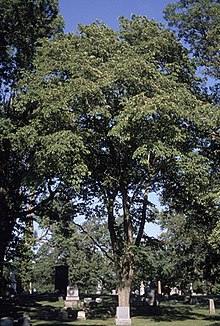Slippery Elm
| Ulmus rubra | |
|---|---|
 |
|
| Mature cultivated slippery elm (Ulmus rubra) | |
| Scientific classification | |
| Kingdom: | Plantae |
| (unranked): | Angiosperms |
| (unranked): | Eudicots |
| (unranked): | Rosids |
| Order: | Rosales |
| Family: | Ulmaceae |
| Genus: | Ulmus |
| Species: | U. rubra |
| Binomial name | |
|
Ulmus rubra Muhl. |
|
 |
|
| Natural range of Ulmus rubra | |
| Synonyms | |
|
|
Ulmus rubra, the slippery elm, is a species of elm native to eastern North America, ranging from southeast North Dakota, east to Maine and southern Quebec, south to northernmost Florida, and west to eastern Texas, where it thrives in moist uplands, although it will also grow in dry, intermediate soils.
Other common names include red elm, gray elm, soft elm, moose elm, and Indian elm. The tree was first named as part of Ulmus americana in 1753, but identified as a separate species, Ulmus rubra, in 1793 by Pennsylvania botanist Gotthilf Muhlenberg. The slightly later name U. fulva, published by French botanist André Michaux in 1803, is still widely used in dietary-supplement and alternative-medicine information.
The species superficially resembles American elm U. americana, but is more closely related to the European wych elm U. glabra, which has a very similar flower structure, though lacks the pubescence over the seed.U. rubra was introduced to Europe in 1830.
Ulmus rubra is a medium-sized deciduous tree with a spreading head of branches, commonly growing to 12–19 m (39–62 ft), very occasionally < 30 m (98 ft) in height. Its heartwood is reddish-brown, giving the tree its alternative common name 'red elm'. The species is chiefly distinguished from American elm by its downy twigs, chestnut brown or reddish hairy buds, and slimy red inner bark. The broad oblong to obovate leaves are 10–20 cm (4–8 in) long, rough above but velvety below, with coarse double-serrate margins, acuminate apices and oblique bases; the petioles are 6–12mm long. The leaves are often red tinged on emergence, turning dark green by summer, and then a dull yellow in the fall; The perfect, apetalous, wind-pollinated flowers are produced before the leaves in early spring, usually in tight, short-stalked, clusters of 10–20. The reddish-brown fruit is an oval winged samara, orbicular to obovate, slightly notched at the top, 12–18 mm (1/2–3/4 in) long, the single, central seed coated with red-brown hairs, naked elsewhere.
...
Wikipedia
